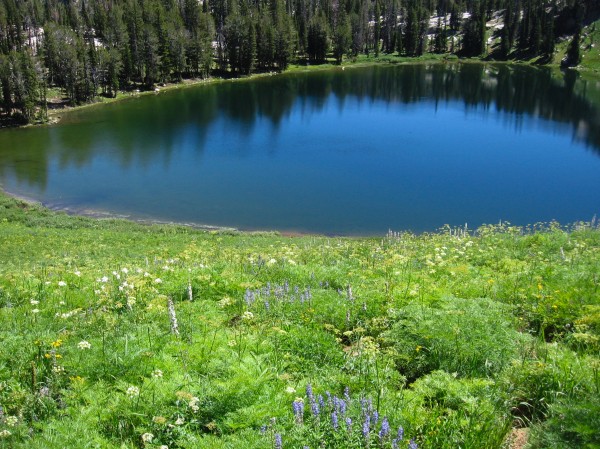# 3-Green Lake
Tucked in behind the steep east side of Green Mountain is Green Lake, another of our favorite Grand Teton horseback riding trails. The trail leading to this high mountain lake begins on a densely vegetated slope, where snowberry and serviceberry are just beginning to bloom. Later in summer huckleberries will be ripe for picking.
The trail opens onto the broad face of Green Mountain; by mid-July the wildflowers are breathtaking.
“When the white wild carrot blooms across the face of the mountain I feel as if I’m drifting on a cloud.”
A steep switchback trail drops down to the lake, where fishing, lounging,
and dipping toes, if you dare,
in the cold mountain water, are permitted. For riders who want to venture further, we explore the smaller lakes and subalpine meadows above Green Lake.
Portions of the trail are steep and rocky so riders must have previous riding experience.
Natural History On Horseback
Red-tailed Hawk
 A common raptor seen in our area is the Red-tailed Hawk (Buteo jamaicensis). A screeching kee-arr often alerts you to the bird soaring overhead. When an intruder enters the nesting territory the pair will often circle, making a shrill chirping sound. But the typical adult Red-tailed Hawk’s distinctive red tail is the best field mark. When you drive through the countryside, look for the bird perched on telephone poles, fenceposts, and in trees at the edge of an open field. Red-tails typically build their nests in the crown of a tree so they have a favorable view of their territory. They primarily eat small mammals, but they also eat birds and carrion. Mated pairs typically stay together until one of the birds dies.
A common raptor seen in our area is the Red-tailed Hawk (Buteo jamaicensis). A screeching kee-arr often alerts you to the bird soaring overhead. When an intruder enters the nesting territory the pair will often circle, making a shrill chirping sound. But the typical adult Red-tailed Hawk’s distinctive red tail is the best field mark. When you drive through the countryside, look for the bird perched on telephone poles, fenceposts, and in trees at the edge of an open field. Red-tails typically build their nests in the crown of a tree so they have a favorable view of their territory. They primarily eat small mammals, but they also eat birds and carrion. Mated pairs typically stay together until one of the birds dies.
To learn more about identifying raptors view this video from Peterson Field Guides:




